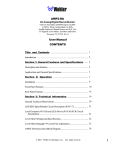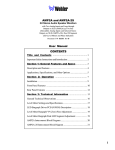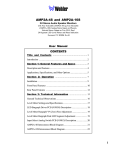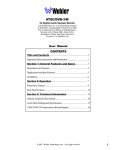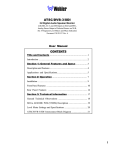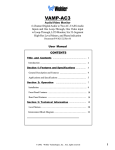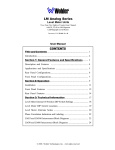Download Wohler AMP2-V2DA User manual
Transcript
AMP2-V2DA 2U Digital/Analog Audio Speaker Monitor with Two AES Inputs on BNC and XLR, Four Analog Inputs on Phoenix, Four Analog Outputs From AES on Phoenix, Selected Analog Stereo Outpts on XLR, Four 53-Segment Level Meters, and Phase Indication Document P/N 821539 Rev. A User Manual CONTENTS Title and Contents ...................................................... 1 Introduction ...................................................................................... 2 Section 1: General Features and Specs .................. 3 General Description and Features ................................................... 4 Applications and Specifications ....................................................... 5 Section 2: Operation ................................................. 7 Installation ....................................................................................... 9 Front Panel Features ........................................................................ 10 Rear Panel Features ......................................................................... 14 Section 3: Technical Information ............................ 19 General Technical Observations ...................................................... 20 AES/EBU to Analog Converter PCB (919050) Description ............ 21 Level Meter Settings and Specifications ........................................... 22 Level Meter Bargraph "0" (Zero) Fine Adjustment .......................... 23 Level Generator (919126) and LED Driver (919110) PCB Descriptions ..................................................................................... 23 AMP2-V2DA Interconnect Block Diagram ...................................... 24 1 Important Safety Instructions 1) Read these instructions. 2) Keep these instructions. 3) Heed all warnings. 4) Follow all instructions. 5) Do not use this apparatus near water. 6) Clean only with dry cloth. 7) Do not block any ventilation openings. Install in accordance with the manufacturer's instructions. 8) Do not install near any heat source such as radiators, heat registers, stoves, or other apparatus (including amplifiers) that produce heat. 9) Do not defeat the safety purpose of the polarized or grounding-type plug. A polarized plug has two blades with one wider than the other. A grounding type plug has two blades and a third grounding prong. The wide blade or the third prong are provided for your safety. If the provided plug does not fit into your outlet, consult an electrician for replacement of the obsolete outlet. 10) Protect the power cord from being walked on or pinched, particularly at plugs convenience receptacles and the point where they exit from the apparatus. 11) Only use attachments/accessories specified by the manufacturer. 12) Use only with the cart stand, tripod, bracket, or table specified by the manufacturer, or sold with the apparatus. When a cart is used, use caution when moving the cart/apparatus combination to avoid injury from tip-over. 13) Unplug this apparatus during lightning storms or when unused for long periods of time. 14) Refer all servicing to qualified service personnel. Servicing is required when the apparatus has been damaged in any way, such as when power-supply cord or plug is damaged, liquid has been spilled or objects have fallen into the apparatus, the apparatus has been exposed to rain or moisture, does not operate normally, or has been dropped. 15) Do not expose this apparatus to rain or moisture. 16) The apparatus shall be connected to a mains socket outlet with a protective earthing connection. CAUTION! In products featuring an audio amplifier and speakers, the surface at the side of the unit, where the audio amplifier heat sink is internally attached, may get very hot after extended operation. When operating the unit excercise caution when touching this surface and ensure that external materials which may be adversely affected by heat are not in contact with it. There is a Hot Surface label (see diagram) attached to the aforementioned surface of the product. Introduction Congratulations on your selection of a Wohler Technologies product. We are confident it represents the best performance and value available, and we guarantee your satisfaction with it. If you have questions or comments you may contact us at: Wohler Technologies, Inc. 31055 Huntwood Avenue Hayward, CA 94544 Phone: (510) 870-0810 Fax: (510) 870-0811 US Toll-Free: 1-888-596-4537 www.wohler.com 2 [email protected] © 2007 Wohler Technologies, Inc. ALL rights reserved AMP2-V2DA User Manual P/N 821539 Rev-A Sect. 1: General Features and Specifications Section 1 General Features and Specifications Description Features Applications Specifications © 2001 Wohler Technologies Inc. ALL rights reserved 3 AMP2-V2DA User Manual P/N 821539 Rev-A Section 1: General Features and Specifications AMP2-V2DA Powered Analog/DigitalAudio Monitor SOURCE POWER 8 6 4 2 0 2 SOURCE 6 1 AVG 15 12 8 6 4 2 0 2 ANALOG AES 1 6 DIGITAL 10 12 15 18 22 26 30 35 40 50 WOHLER TECHNOLOGIES SOURCE PHASE FAST 15 12 1 2 3 4 1 2 3 4 2 3 LEFT SPKR AMP2-V2DA 10 12 15 18 22 26 30 35 40 50 AES 2 DIGITAL AUDIO MONITOR PANEL 4 RIGHT SPKR AMP2-SDA Front Panel Description The AMP2-V2DA is a complete, exceptionally high quality AES digital/analog stereo audio monitoring system in a compact, two rackspace cabinet. It contains three audiophile-quality drivers and three power amplifiers; two amplifiers (and two speakers) that reproduce midrange and high frequency information in stereo, and a third amp/driver combination (and speaker) that handles summed Low Frequency (LF) information below the 500 Hz crossover point. The AMP2 series unique audio design has two important advantages. First, it provides optimally focused sound in an Ultra Near Field tm (1 to 3 feet) environment. This allows higher SPL for the operator while reducing overall ambient sound and adjacent bay crosstalk. Second, electronic rather than acoustic cancellation of bass frequencies provides positive audible detection of reversed polarity (“out of phase”) audio feeds. A unique LED display also visually shows “phase” (polarity) relationships of signals selected for monitoring. All AMP2 Digital models come equipped with a ganged stereo volume control and balance pot, power indication LED, and headphone output. Output limiter circuits are incorporated to protect the speakers, and extensive magnetic shielding allows placement immediately adjacent to video monitors with no color impurities. The AMP2-V2DA is an analog and digital (AES/EBU) audio monitor capable of audibly monitoring two of four selected source channels through it's stereo speaker system while simultaneously visually monitoring all four channels of the selected source via four LED bargraph level meters. A toggle switch on the front panel allows selection between analog or AES digital input sources. Two four-position rotary switches on the front panel are used to independently assign any two of the selected four channels to the left and right speakers. AES signal status is indicated by two bi-color (red/green) LEDs. The rear panel features two AES inputs on unbalanced BNC connectors, two AES loop-through outputs on unbalanced BNC connectors, two AES inputs on balanced XLR connectors, four analog inputs on balanced Phoenix connectors, four analog outputs of the AES source on Phoenix connectors, and a stereo analog output of the two channels assigned to the left and right speakers on two balanced XLR connectors. Four high-resolution 53-segment tri-color LED bargraph level meters display the audio levels for the left and right selected sources. Wohler Technologies proprietary three-LED stereo phase indication feature allows monitoring of phase relationships of the selected stereo inputs. Features • 104 dB SPL at two feet • Analog outputs (converted from the AES inputs) on four Phoenix connectors • Only two rack spaces high • Excellent high frequency response for positive detection of background whine and noise • Audible and visual indication of phase/polarity problems • Thorough magnetic shielding for placement next to video monitors • Four high-resolution 53-segment tri-color LED bargraph level meters • Analog outputs of source selected for speaker monitoring on two balanced XLR connectors • Two 4-position speaker assign selection switches • Two AES signal status indication LEDs • Digital/analog source selection via front panel toggle switch • Headphone output • Power indication LED • AES/EBU inputs on two unbalanced BNC connectors with loop-through outputs on two unbalanced BNC connectors • Numerous control and input options • AES/EBU inputs on two balanced XLR connectors • Quick and easy installation: simply slide in the rack and connect audio and AC power • Analog inputs on four balanced Phoenix connectors 4 © 2001 Wohler Technologies Inc. ALL rights reserved AMP2-V2DA User Manual P/N 821539 Rev-A Section 1: General Features and Specifications Applications The AMP2-V2DA is ideally suited for use in VTR bays, mobile production vehicles, teleconferencing installations, multimedia systems, satellite links and cable TV facilities, and on-air radio studios. Designed and manufactured in the U.S., the AMP2-V2DA is backed by a strong warranty and a satisfaction guaranteed return policy. General Specifications AES Input Specifications Input Connectors: AES=BNC and XLR / Analog=Phoenix AES termination: DIP switch selectable Analog Input impedance: AES Input impedance: Phoenix: 200K Ω, balanced BNC: 75 Ω, unbal. / XLR: 110 Ω, bal. AES sampling rate: 32-48 kHz, auto-select D to A converter: 18-bit low jitter Peak Acoustic Out (@ 2 ft.): 104 dB SPL D to A gain calibration, DIP switch selectable; (dBFS = dB): -18=0, -9=+6, -20=+4, -20=+8 Power output, Ω): RMS Each Side (4Ω Ω): RMS Bass (4Ω 14 W transient / 10 W continuous 35 W transient / 25 W continuous Frequency Response, Sixth Octave: 80 Hz - 16 kHz ± 5 dB) (-10 dB @ 40 Hz, 20 kHZ) Level Meter Specifications Level meter type: Meter dynamics: Input Level for Maximum Output (Volume Full On): 0 dBv balanced / -10 dB unbalanced Hum and Noise (analog): Better than -68 dB below full output Distortion, Electrical: Less than 0.15% at any level below input threshold Distortion, Acoustic: 6% or less at worst case frequencies above 120 Hz, including cabinet resonance; typically less than 1.5% Input Overload: +26 dBv balanced Converted analog out S/N: >90 dB Converted analog out THD: <0.008% Magnetic shielding: <0.8 Gauss any adjacent surface Power consumption (Average Maximum): 45 W AC Mains input: 100-240VAC, 50-60 Hz Universal 53-Segment LED bargraph . VU (bar) and/or PPM (dot), select Dynamics modes: PPM: 20 dB decay in 1.5 sec. or 3 sec hold VU: 3 sec. hold or 10 sec. hold Level gain: 0, +4, +6, +8 dBu, select Dynamic range: 65 dB Midscale resolution: 1 dB Segment colors: Tricolor (green, amber, red) Scale: +16 to -50 dB Segment size: .158" x .04" (4.0132 x 1.016 mm) Physical Specifications Weight: 18 lbs. (8.2 kg) Dimensions (HxWxD): 3.5 x 19 x 12 inches (89 x 483 x 305 mm) Custom combinations of connectors, controls and level meters are available by special order. Audio Response Curve +10 0 d B -10 -20 -30 20 50 100 200 500 1k 2k 5k 10k 20k Hz Typical 1/6 Octave Audio Response Curve Units are designed to meet, at time of manufacture, all currently applicable product safety and EMC requirements, such as those of UL and CE. 0 dbV ref. 0.775V RMS. Features and specifications subject to improvement without notice. © 2001 Wohler Technologies Inc. ALL rights reserved 5 AMP2-V2DA User Manual P/N 821539 Rev-A 6 © 2001 Wohler Technologies Inc. ALL rights reserved AMP2-V2DA User Manual P/N 821539 Rev-A Section 2 Operation Installation Front Panel Features Rear Panel Features © 2001 Wohler Technologies Inc. ALL rights reserved 7 AMP2-V2DA User Manual P/N 821539 Rev-A 8 © 2001 Wohler Technologies Inc. ALL rights reserved Section 2: Operation AMP2-V2DA User Manual P/N 821539 Rev-A Section 2: Operation Installation Mounting NOTE: Be sure to set the level meter Gain Calibration and Display Mode DIP switch (accessed through the top cover) and Input Termination and Input Gain Calibration (accessed through the rear panel), BEFORE installing the unit into an enclosed rack or console. See pages 14 and 22 for setting information. The unit should be mounted where convenient for operating persons, ideally at approximately ear level for best high frequency response. Its superior magnetic shielding eliminates concerns about locating it adjacent to most types of CRT monitors, including even high-resolution color monitors. Heat Dissipation Heat dissipated by the speaker amps is conducted directly to the left side of the chassis; no special considerations for cooling are necessary as long as the ambient temperature inside the rack area does not exceed approximately 40°C (104°F). Sympathetic Vibration Sympathetic vibration from other equipment (cables, etc.,) in the rack may be serious enough to interfere with the unit’s sound quality out in the listening area. The use of thin card stock and/or felt or foam weather-stripping type materials between adjacent vibrating surfaces, or tying up loose cables, etc., may be required to stop vibrations external to the unit. Mechanical Bracing Even though the unit is fairly heavy, the chassis is securely attached to the front panel at eight points along its surface, not just at the four corners of the chassis ears. This feature will reduce or eliminate rear bracing requirements in many mobile/portable applications. The weight of internal components is distributed fairly evenly around the unit. Audio Connections Connection of the audio feeds is straightforward. Please refer to the system interconnect block diagram on page 24 for clarification of the general signal paths into and out of the AMP2-V2DA unit. AES/EBU inputs are via either female BNC or 3-pin female XLR connectors. Digital BNC inputs are 75 Ω unbalanced; digital XLR inputs are 110 Ω balanced. Analog inputs are via four 3-pin Phoenix screw-clamp connectors. Analog inputs are 200K Ω balanced. Care should be exercised to avoid mismatched cable types and other similar causes of undesired reflections in RF signal systems. If severe enough, such reflections can result in corruption of the digital datastream. Electrical Interference As with any audio equipment, maximum immunity from electrical interference requires the use of shielded cable; however, satisfactory results can sometimes be obtained without it. The internal circuitry common is connected to the chassis. AC Power The unit's AC mains connection is via a standard IEC inlet, with safety ground connected directly to the unit's chassis. The universal AC input (100-240VAC, 50/60Hz) switching power supply is a self-resetting sealed type, with automatic over-voltage and over-current shutdown. There is no user-replaceable fuse in either the primary or secondary circuit. © 2001 Wohler Technologies Inc. ALL rights reserved 9 AMP2-V2DA User Manual P/N 821539 Rev-A Section 2: Operation Front Panel Features Please refer to Figure-2a on the following page to familiarize yourself with the front panel features of the AMP2-SDA unit. The following sections describe these features and are referenced, by number, to Figure-2a. 1 Speakers The AMP2-V2DA internal speaker system is comprised of two mid-range tweeter speakers (left and right) and one woofer speaker (center). The two side channel speakers reproduce, in stereo, only the mid and high frequencies. Please note that the woofer speaker (center) is not a dedicated Center nor LFE speaker. 2 Power Indication LED This LED glows green to indicate the AMP2-V2DA is connected to mains power and an operation voltage is present. 3 Audio Level Meter LED Bargraph Displays (1-4) Audio levels for the selected 4-channel source is visually displayed via these four high-resolution, 53-segment, tri-color LED bargraph meters. Dynamic range for these meters is 65 dB and they are able to simultaneously display signal levels using either PPM or VU standards. Alternate display modes are user selectable via a DIP switch accessible through the top cover of the AMP2-V2DA (see page 22 and 23 for DIP switch settings and additional meter information). Contact the factory for additional information concerning meter scales and ballistics. 4 Volume Control Pot This controls the loudness of the audio reproduced by the internal speakers or connected headphone. Clock-wise rotation of this control increases the loudness of the monitored audio. 5 Speaker Monitor Select (Left and Right) Use the left switch to select any one of four selected channels for monitoring from the left speaker. Use the right switch to select any one of four selected channels for monitoring from the right speaker. Note that the Analog/Digital Source Select Switch (Item 7) determines which four channel source (Analog or AES) is available for assignment to the left and right speakers. 6 Headphone Jack Select the headphone audio sources as you would for the internal speakers. When you plug in headphones, the internal or external speakers will mute. This jack accepts a standard 1/4” phone type stereo plug. 7 Analog/Digital Source Select Switch This two position toggle switch allows the operator to choose between two primary input sources; "ANALOG" or "DIGITAL". When this toggle switch is set to "ANALOG", the unit will monitor the signals as input on the rear panel "ANALOG IN" Phoenix connectors (Item F, page 16). When this toggle switch is set to "DIGITAL", the unit will monitor the two AES IN inputs; 1 and 2 (Items B or C, page 14). 8 Bargraph Brightness Trim Pot This control is recessed into the front panel and can be accessed using a small screwdriver. Turning it clockwise will increase the relative brightness of the bargraph display LED segments. Adjusting this one control will simultaneously affect the brightness of all bargraph displays on the front panel. 9 Phase Indication LEDs These three LEDs offer instant verification of phase (polarity) conditions in the pair of channels selected for monitoring in the Left/Right channel speakers. There are three LEDs; the two smaller LEDs labeled "FAST" (left side of the "PHASE" section) show instantaneous phase relationships in the signal, while the larger LED, labeled "AVG" (right side of the "PHASE" section), will indicate the average phase condition. The small "FAST" LED on the left glows (or blinks) green when signals are in-phase. The small "FAST" LED on the right glows (or blinks) amber for out-of-phase signals. The larger "AVG" LED indicates the average phase condition by glowing green for in-phase conditions, or red for out-of-phase conditions. In general, it is sufficient to regard the "AVG" LED (average phase condition) as adequate for proper phase monitoring. While it is normal for stereo signals to contain some intermittant instantaneous out-of-phase and in-phase conditions (small LEDs), a steady red glow of the larger LED almost always indicates an out-of-phase alarm condition. (Continued) 10 © 2001 Wohler Technologies Inc. ALL rights reserved WOHLER TECHNOLOGIES 1 2 POWER 1 SOURCE 15 12 6 8 6 4 2 0 2 10 12 15 18 22 26 30 35 40 50 3 2 4 ANALOG SOURCE 3 4 DIGITAL 1 2 LEFT SPKR 5 6 7 8 FAST PHASE 1 9 AVG AES 1 AES 2 1 2 3 4 10 RIGHT SPKR 5 3 SOURCE 15 12 8 6 4 2 0 2 6 10 12 15 18 22 26 30 35 40 50 3 11 4 1 DIGITAL AUDIO MONITOR PANEL AMP2-V2DA 11 Wohler Technologies Inc. ALL rights reserved © 2001 Section 2: Operation AMP2-V2DA User Manual P/N 821539 Rev-A Figure-2a: Front Panel Features AMP2-V2DA User Manual P/N 821539 Rev-A Section 2: Operation Front Panel Features (Continued) 10 Balance Control Pot This pans the volume balance between the left and right speakers. If the balance is adjusted hard left or hard right, a slight left/ right channel mix is retained (only in low bass frequencies) so that phase discrepancies can be discerned. 11 AES Signal Error Indication LEDs (AES 1 and AES 2) These two bi-color (GREEN/RED) LEDs indicate the input presence and status of the two AES input signals. These LEDs function whether or not the AES digital signals are selected for monitoring through the unit. Either LED glows GREEN as long as a valid AES/EBU digital datastream for the associated input channel is being received. Either LED glows RED to indicate errors in reception or data errors (if the data has been tagged as inappropriate for conversion to analog by having the validity bit set). Note: If you wish to disable data error indication (and leave only indication of reception errors) you can place jumpers on H14 and H18 of the 919050 AES-to-Analog conversion PCB (see page 26 for component locations). 12 © 2001 Wohler Technologies Inc. ALL rights reserved WOHLER TECHNOLOGIES 1 2 POWER 1 SOURCE 15 12 6 8 6 4 2 0 2 10 12 15 18 22 26 30 35 40 50 3 2 4 ANALOG SOURCE 3 4 DIGITAL 1 2 LEFT SPKR 5 6 7 8 FAST PHASE 1 9 AVG AES 1 AES 2 1 2 3 4 10 RIGHT SPKR 5 3 SOURCE 15 12 8 6 4 2 0 2 6 10 12 15 18 22 26 30 35 40 50 3 11 4 1 DIGITAL AUDIO MONITOR PANEL AMP2-V2DA 13 Wohler Technologies Inc. ALL rights reserved © 2001 Section 2: Operation AMP2-V2DA User Manual P/N 821539 Rev-A Figure-2a: Front Panel Features AMP2-V2DA User Manual P/N 821539 Rev-A Section 2: Operation Rear Panel Features Please refer to Figure-2b on the following page to familiarize yourself with the rear panel features of the AMP2V2DA unit. The following sections describe these features and are referenced, by letter, to Figure-2b. A Power Connector Attach a standard IEC-320 power cord between this connector and mains power (100 - 250VAC, 50/60 Hz). The front panel Power Indication LED (Item 2, page 10) will glow GREEN to indicate operating voltages are present. B AES Input Connectors (AES IN 1 and AES IN 2) These two AES IN input connectors are meant to receive standard AES/EBU signals. These 3-pin female XLR connectors are configured for an balanced, 110 Ω connection. Note that the unit will monitor the AES/EBU IN input only when the Analog/ Digital Source Select Switch (Item 7, page 10) is set to "DIGITAL". For XLR pinout information see the diagram under Selected Analog Output Connectors (Item H, page 16). Note: You cannot input digital signals simultaneously to one of the AES XLR input connector channels (1 or 2) and the same channel on the corresponding AES BNC input connector (Item C). C AES Input Connectors (IN 1 and IN 2) and Loop-Throughs (OUT 1 and OUT 2) These two AES IN BNC input connectors are meant to receive standard AES/EBU signals. The AES OUT female BNC loopthrough connectors (1 and 2) output a copy of the signal entering the corresponding AES IN input connectors (1 and 2). All four female BNC connectors are configured for an unbalanced, 75 Ω connection. Note that the unit will monitor the AES IN inputs only when the Analog/Digital Source Select Switch (Item 7, page 10) is set to "DIGITAL". Note: You cannot input digital signals simultaneously to one of the AES BNC input connector channels (1 or 2) and the same channel on the corresponding AES XLR input connector (Item B). D AES Input Termination DIP Switch This 4-position DIP switch is used to set the termination characteristics for the AES inputs. In the event that either of the two AES input channels is fed to downstream equipment (via the loop-throughs or "Y" or "T" connectors), then the associated DIP switch section (S1=IN 1, S3=IN 2) must be placed in the Unterminated (UP) position. If there is no downstream equipment connected, then the associated DIP switch section must be placed in the Terminated (DOWN) position. See below for a diagram of termination settings. Note: Sections S2 and S4 are not used. AES Input 1 Termination (919050) Term. 1 Term. 2 Term. 1 Term. 2 AES Input 2 Termination (919050) Term. 1 Term. 2 Term. 1 Term. 2 1 2 3 4 1 2 3 4 1 2 3 4 1 2 3 4 IN 1 Unterminated IN 1 Terminated IN 2 Unterminated IN 2 Terminated Note: Positions S2 and S4 of DIP switch are not used. E AES Input Level Gain Calibration DIP Switch Input Level Gain Calibration, the analog level which corresponds to a given digital input value, is settable via this DIP switch. The factory setting is +4 dB (analog) = -20 dBFS (digital). See the silk-screened chart on the rear panel or the diagram below for Gain Calibration settings. AES D/A Conversion Gain Calibration Settings 0 dB = -18 dBFS +4 dB = -20 dBFS +6 dB = -9 dBFS +8 dB = -20 dBFS 12 (Continued) 14 © 2001 Wohler Technologies Inc. ALL rights reserved AES IN 2 OUT 1 IN 2 TERM 2 1 2 3 4 D OUT 2 C -20 -20 DIGITAL GAIN CALIB dB dBFS +4 -18 -9 +8 0 +6 1 2 GAIN CALIB. E 2 3 3 4 4 ANALOG IN 2 1 1 CONVERTED ANALOG OUT HI LO AES IN 1 IN 1 TERM 1 AES/EBU PORTS C HI LO INTERNAL POWER B HI LO UNDERWRITERS LABS SEE POWER SUPPLY LABEL ON SIDE SERIAL NUMBER 100-240 VAC 50/60 Hz A HI LO F G CH. A (L) CH. B (R) SELECTED ANALOG OUTPUT H AMP2-V2DA 253362 15 Wohler Technologies Inc. ALL rights reserved © 2001 Section 2: Operation AMP2-V2DA User Manual P/N 821539 Rev-A Figure-2b: Rear Panel Features Section 2: Operation AMP2-V2DA User Manual P/N 821539 Rev-A Rear Panel Features (Continued) F Analog Input Connectors (1-4) These four analog input connectors accept standard analog audio signals. These four 3-pin male Phoenix connectors are configured for a balanced 200k Ω connection. Phoenix connector pin-out information is silk-screened just below the CONVERTED ANALOG OUT connectors (Item G). Note that the unit will monitor the Analog inputs only when the Analog/ Digital Source Select Switch (Item 7, page 10) is set to "ANALOG". G Converted Analog Out Connectors (1-4) These four Phoenix connectors output analog signals converted from the four AES/EBU digital inputs (but not the analog inputs) and are not affected by the position of the Analog/Digital Source Select Switch (Item 7, page 10). These 3-pin male Phoenix connectors are configured for a balanced low impedance connection. Phoenix connector pin-out information is silk-screened just below these connectors. H Selected Analog Output Connectors These two 3-pin male XLR connectors are analog outputs of the selected source as assigned to the left and right speakers. The left connector outputs the left channel (channel A) and the right outputs the right channel (channel B). Both connectors are configured for low impedance connections and the output signals are not affected by the volume/balance controls or headphone mute. For XLR pinout information see the diagram below. Pin-2 High (+) 16 Pin-1 Gnd (Shield) Pin-1 Gnd (Shield) Pin-2 High (+) Pin-3 Low (-) Pin-3 Low (-) Female XLR Pinout Male XLR Pinout © 2001 Wohler Technologies Inc. ALL rights reserved AES IN 2 OUT 1 IN 2 TERM 2 1 2 3 4 D OUT 2 C -20 -20 DIGITAL GAIN CALIB dB dBFS +4 -18 -9 +8 0 +6 1 2 GAIN CALIB. E 2 3 3 4 4 ANALOG IN 2 1 1 CONVERTED ANALOG OUT HI LO AES IN 1 IN 1 TERM 1 AES/EBU PORTS C HI LO INTERNAL POWER B HI LO UNDERWRITERS LABS SEE POWER SUPPLY LABEL ON SIDE SERIAL NUMBER 100-240 VAC 50/60 Hz A HI LO F G CH. A (L) CH. B (R) SELECTED ANALOG OUTPUT H AMP2-V2DA 253362 17 Wohler Technologies Inc. ALL rights reserved © 2001 Section 2: Operation AMP2-V2DA User Manual P/N 821539 Rev-A Figure-2b: Rear Panel Features AMP2-V2DA User Manual P/N 821539 Rev-A 18 © 2001 Wohler Technologies Inc. ALL rights reserved Section 2: Operation AMP2-V2DA User Manual P/N 821539 Rev-A Section 3 Technical Information • General Technical Observations • AES to Analog Converter Module PCB (919050) • Level Meter Settings and Specifications • Level Meter Bargraph "0" (Zero) Fine Adjustment • Level Generator (919126) and LED Driver (919110) PCB Descriptions • AMP2-V2DA Interconnect Block Diagram © 2001 Wohler Technologies Inc. ALL rights reserved 19 AMP2-V2DA User Manual P/N 821539 Rev-A Section 3: Technical Information General Technical Observations General Mechanical Observations Elimination of cabinet and component sympathetic vibrations (resonances) requires considerable attention to mechanical details. Because of this, and the physical constraints of the speaker’s acoustic enclosures, even minor changes to any of the mechanical details of the unit can seriously impair its acoustic performance. This especially applies to the speaker baffles. If mechanical work on the unit is necessary, be sure to make adequate notes to permit accurate reassembly. Unfortunately, the unusual and wholly proprietary method of magnetic shielding is usually degraded slightly by any disassembly of the unit, except removal of the rear panel. Almost any maintenance or repair will require removal of the cover. If an immediately adjacent video monitor shows magnetic interference after reassembly of the unit, it must be returned to the factory to restore the shielding completely. General Audio Circuitry Observations Since a single-sided power supply is used, all amplifier sections are “biased” with a 1/2 supply reference, so all opamp signal terminals on the main board should have a DC level of +12V, +/-0.7V. Signal inputs to the main audio board from any of the input select circuits are via the balanced input stage, in lieu of the XLR analog inputs on the basic unit. Signal feed points for level meters and the phase indicator are immediately after the input stage, and before the volume control section. The signal pick-off for the headphones is after the volume and balance controls. Speaker muting is controlled by circuitry that senses connection of headphones to the jack. The power amps are attached to an aluminum heatsink plate (which is also connected to the circuit common for these devices). The heatsink plate forms an operational module separate from the chassis, which allows access to the solder side of the circuit board while power is applied to the circuitry. To avoid thermal shutdown of the power amp(s), they should NOT be operated without their tabs being fastened to the heatsink plate. Variations in the frequency response of different production runs of drivers has sometimes required minor adjustments in the equalization/crossover components in individual runs of units. Some of these components may have values slightly different than those indicated in the schematic, which are the nominal ones. If any of the drivers (speakers) are replaced, it may be helpful to change some of these components to achieve maximum flatness of response. The operating threshold of the woofer limiter is critical to both satisfactory reproduction of musical transients and preventing damage to, or destruction of, the speaker itself. The side speaker output limiter circuits are similarly important, though not as critically adjusted. The woofer power amps are arranged in a bridge configuration; care must be taken to avoid letting EITHER speaker terminal contact the chassis (common) OR THE GROUNDED LEAD OF ANY TEST EQUIPMENT so as not to short out the power amps. The side speaker outputs are single-ended, so these precautions are not necessary for them. 20 © 2001 Wohler Technologies Inc. ALL rights reserved AMP2-V2DA User Manual P/N 821539 Rev-A Section 3: Technical Information AES/EBU to Analog Converter Module PCB (919050) Description The Digi-2 (dual input AES/EBU to analog converter module PCB) allows selected Wohler Technologies products to receive input signals in the AES/EBU or SPDIF digital audio data formats. Sampling rate and format selection are sensed and set automatically. Two front panel mounted bi-color (red/green) LEDs provide visual indication of input signal status. The LEDs light green when receiving a valid, error-free data stream but turn red when errors are detected. There are two AES/EBU inputs, which can be configured with unbalanced 75 Ω BNC connectors or balanced 110 Ω XLR connectors. This PCB also features a four-channel balanced analog line-level output, which can be configured with unbalanced 75 Ω BNC connectors or balanced 110 Ω Phoenix or XLR connectors. 919050 Specifications Input formats: AES/EBU or SPDIF Digital-to-Analog Conversion: 24-bit low jitter Sampling rate: 31 kHz to 48 kHz Termination: Removable (DIP switch selectable) Analog out (of digital source), S/N: Greater than 96 dB THD (full output): Less than 0.008% Max output of analog out: +24 dBv (0 dBv = 0.775 vRMS) Nominal output level for "Full Code" digital source: +24 dBv D to A gain calibration, (dB = dBFS): +8 = -20, +4 = -20, +6 = -9, 0 = -18 (DIP switch selectable) Standard input connectors: Optional input connectors: BNC: 75 Ω, unbalanced Phoenix or XLR: 110 Ω, balanced Standard output connectors: Optional output connectors: BNC: 75 Ω, unbalanced Phoenix or XLR: 110 Ω, balanced Error Indication: Two Bi-Color LEDs (on front panel): Green = OK Red = Error, no lock to signal, or no signal. © 2001 Wohler Technologies Inc. ALL rights reserved 21 AMP2-V2DA User Manual P/N 821539 Rev-A Section 3: Technical Information Level Meter Settings and Specifications Level Meter DIP Switch Settings A DIP switch module, accessed through holes in the top cover, allows the user to set the Bargraph Display Mode and Meter Input Gain Calibration. There is one DIP switch module for each pair of meter bargraphs. There are four sections (1, 2, 3, 4) on each DIP switch module. The first two sections (1, 2) are for setting the Meter Input Gain Calibration and the second two sections (3, 4) are for setting the Bargraph Display Mode. Meter Input Gain Calibration Settings: DIP switch sections 1 and 2 set the Meter Input Gain Calibration, which determines the level of the input signal (after digital to analog conversion) that will result in a "0" reading on the meter bargraphs. The factory setting is +4 dBu, but can instead be set for 0 dBu, +6 dBu, or +8 dBu by the user. See the diagram below for settings. Bargraph Display Modes: DIP switch sections 3 and 4 (S3 and S4) determine how peak levels are displayed (Display Mode). S3 selects either the "PPM" mode or an auto-reset "VU Peak" mode (NOT the PPM value!). If S3 is set for PPM mode, S4 determines whether it is displayed in the original "floating PPM dot" mode (no Hold, continuous decay of 20 dB in 1.5 seconds) or as a 3 second auto-reset Hold. When S3 is set for "VU Peak", S4 sets the Hold time to either 3 or 10 seconds. The factory setting is PPM Decay mode (no Hold, continuous decay of 20 dB in 1.5 seconds). See the diagram below for settings. PPM 3 Sec Hold Display Mode VU Peak PPM 3 Sec Hold Decay 34 34 Gain Calibration VU Peak 10 Sec Hold 34 34 0 dBu +4 dBu +6 dBu +8 dBu 12 12 12 12 Installation Note: The Meter Input Gain Calibration/Bargraph Display Mode DIP module(s) is accessible through openings in the top cover of the unit. Any adjusments to DIP switch module(s) should be performed before installing the unit into an enclosed rack. LED Bargraph Level Meter Specifications Level meter type: LED bargraph Segment quantity: 53 Meter display modes (DIP switch selectable): VU (bar) or PPM (dot) PPM characteristics (DIP switch selectable): 20 dB decay in 1.5 seconds or 3 second hold 22 VU characteristics (DIP switch selectable): 3 second hold or 10 second hold Level gain (DIP switch selectable): 0, +4, +6, +8 dBu Level meter scale: +16 to -50 dB Dynamic range: 65 dB Midscale resolution: 1 dB Bargraph Length: 2.22" (56.4 mm) LED segment size: 0.14" x 0.028" (3.57 x 0.7 mm) LED segment pitch: 0.041" (1.05 mm) Segment display color: Tri-color (red, amber, green) Peak emmision wavelength: Green: 570 nm, Red: 630 nm Segment brighness, (If = 20 mA): 3.5 mcd Segment brightness, uniformity: <10% difference between segments Adjacent segment "Off" brightness: <1% of brightness of active segment © 2001 Wohler Technologies Inc. ALL rights reserved 53-Segment Bargraph Scale AMP2-V2DA User Manual P/N 821539 Rev-A Section 3: Technical Information Level Meter Bargraph "0" (zero) Fine Adjustment Note: For range setting, use the Meter Input Gain Calibration/Bargraph Display Mode DIP Switches 1) Removal of the Top Cover Remove the top cover screws (2 along upper front panel, 2 per each side, 3 along upper rear panel). The 919126 PCB is vertically mounted to chassis bottom just behind the front panel mounted LED driver PCB (see photo below). 2) Adjustment Pot Locations and Functions On the 919126 PCB(s) the P2 pot adjusts the left (Channel A) bargraph meter and the P3 pot adjusts the right (Channel B) bargraph meter. See diagrams below. 3) “0” Fine Adjustment Setup Connect a test signal of approximately 1 kHz of the amplitude desired to give a “0” indication on the bargraph. This signal should be connected across the balanced inputs, and should be from a balanced source. 4) Fine Adjustment of the Bargraph “0” Level Turning each pot clockwise increases the displayed level (sensitivity) of the associated bargraph meter. For example, to set the zero level at +7 dBu (rather than the factory default setting of +4 dBu), adjust the appropriate DIP switch for gain closest to that desired (see page 22 for Gain Calibration settings). Feed a +7 dBu signal (see step 3) into the analog input on the rear panel (Item H, page 16), then turn the pots counter-clockwise as you visually monitor the associated bargraph meter on the front panel until the desired display setting (“0”) is achieved for the increased input level. To zero the meters for a lower input level, you would turn the pots clockwise to increase the displayed level for any decreased input level. P2 pot adjusts the left bargraph meter. P3 pot adjusts the right bargraph meter. P3 R12 R10 P2 IC5 Turn pots clockwise to increase the display level (sensitivity) in the associated bargraph meter Level Generator (919126) and LED Driver (919110) PCB Descriptions Level Generator Boards (919126) All signals are input to discrete level generator PC boards. Each level generator PC boards responsibility is to process tasks such as Digital Signal Processing (DSP), frequency response, integration time, and VU or PPM “dot” display mode. The ADSP-2115 chip on the each Level Generator board handles the entire processing function. During the assembly of an AMP2 Digital unit, software is programmed and loaded to a socket chip for a specific unit in-house. A standard factory calibration of "0" indication when input level is +4 dBV is set for the calibration level unless specified differently by the end user. A bank of DIP switch sections is located at the rear of Level Generator boards, which can be accessed through the top cover. A combination of DIP switch settings can be used to apply display mode (VU, PPM) and level meter gain. LED Driver Boards (919110) All the digital information processed from the Level Generator PC boards are transfered to the LED driver boards through a 10-pin color coded cable. LED Driver Boards accept fixed-length word serially, and latch the outputs for the bargraph segments corresponding to those bits in the received word, which are set high. Brightness of the bargraph displays can be adjusted to a desired setting by adjusting the trimpot located on the front panel. All bargraph displays are simultaneously adjusted with this one trimpot. © 2001 Wohler Technologies Inc. ALL rights reserved 23 24 4 3 2 © 2001 Wohler Technologies Inc. ALL rights reserved Selected Output (L and R) 1 2 3 4 Rear Panel 4 3 2 1 1 4 3 2 D D A D A D A 4 3 2 1 = XLR-M, 3-Pin, Male = XLR-F, 3-Pin, Female = BNC, Female Right Left SOURCE 2 3 4 1 Analog Input Impedances: Phoenix = 200K Ω, Bal. Level Generator PCB (3/4) 919126 4 3 2 1 4 3 2 1 SOURCE 2 3 4 1 AMP2-V2DA Interconnect Block Diagram AES Input Impedances: BNC = 75 Ω, Unbalanced Phoenix = 110 Ω, Balanced Level Gain & Display Mode (top cover access) DIP Switches = Phoenix, 3-Pin, Male 4 3 2 1 A LEFT Speaker Select Switch Level Generator PCB (1/2) 919126 Analog/Digital Source Select 1 2 3 4 Connector Legend Chan. B (Right) Chan. A (Left) D/A 2 Converter D/A 1 Converter AES Gain Calib. DIP Switch DIGITAL ANALOG 2/4 Switch PCB Plugin Module 919083 AES 2 Dual Input AES to Analog Converter PCB 919050 AES 1 Status LEDs 1 2 3 4 ANALOG IN 1-4 AES IN 2 AES IN 1 AES OUT 2 AES IN 2 1 2 AES Term DIP Switch AES OUT 1 AES IN 1 CONVERTED ANALOG OUT 1-4 1 Rear Panel RIGHT Speaker Select Switch R L AMP2-V2DA Interconnect Block Diagram Balance 2 Bargraph Driver PCB 919110 1 Phase Indication PCB 919084 Audio Amplifier PCB 919100-2 or 919164 Volume AVG Bargraph Brightness Adjust Phase Indication Right Side Speaker Middle Speaker (Woofer) 53-Segment Level Meters 3 4 (Selected Bargraph Driver PCB Source: Chan.3-4) 919110 PHASE Rev-A, 10/03/02 53-Segment Level Meters (Selected Source: Chan.1-2) FAST R L Left Side Speaker Headphone AMP2-V2DA User Manual P/N 821539 Rev-A Section 3: Technical Information Wohler Technologies, Inc. 31055 Huntwood Avenue Hayward, CA 94544 Phone: (510) 870-0810 Fax: (510) 870-0811 US Toll-Free: 1-888-596-4537 www.wohler.com [email protected] AMP2-V2DA User Manual P/N 821539 Rev-A Wohler Technologies, Inc. Wohler Technologies, Inc. 713 Grandview Drive 31055 Huntwood Avenue South San Francisco, CA 94080 Hayward, CA 94544 650 589-5676 Fax: 650 589-1355 Phone: (510) 870-0810 Fax: (510) 870-0811 web: www.wohler.com US Toll-Free: 1-888-596-4537 e-mail: [email protected] www.wohler.com [email protected] © 2001 Wohler Technologies Inc. ALL rights reserved


























